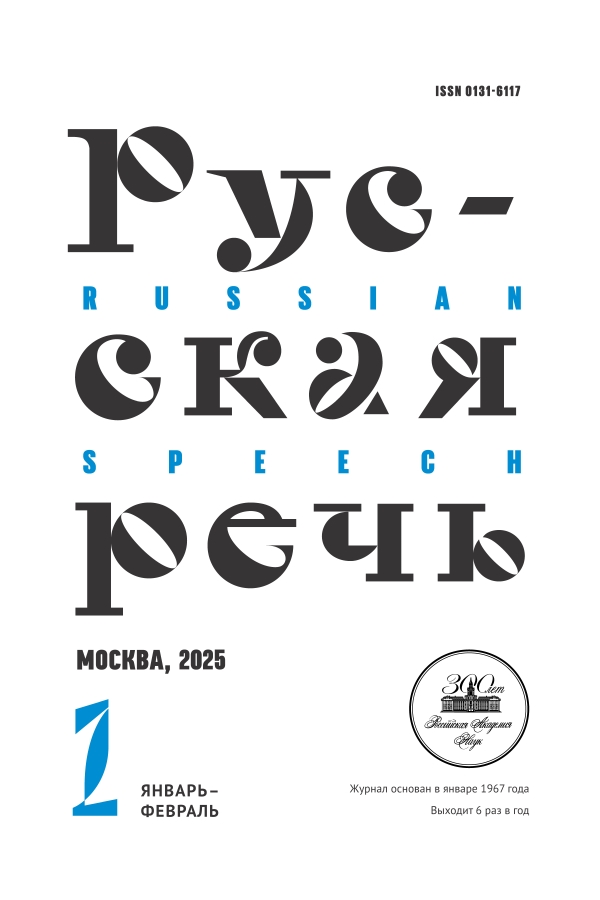Contaminated Russian Speech of Eastern Natives — 20th Century Fiction Characters
- Authors: Streltsov A.A.1
-
Affiliations:
- Southern Federal University
- Issue: No 1 (2025)
- Pages: 98-111
- Section: The Language of Fiction
- URL: https://jdigitaldiagnostics.com/0131-6117/article/view/678663
- DOI: https://doi.org/10.31857/S0131611725010075
- ID: 678663
Abstract
The article features the way fiction writers depict direct speech of non-native characters who are fluent and able to communicate effectively with the native speaker characters. The investigation based on works written by Russian and one Polish author of the 20th century shows how they imagined the speech of indigenous peoples of the Far East who had to talk in Russian. Numerous examples given in this article feature the interfering effect of their native tongues on the second Russian language. The work provides a typology of language means, representing the main kinds of distortions of the Russian speech made by native speakers (Yakut, Oroch, Udege, Nanai, Evenk). The aim of the article is to establish regular distortions in the contaminated Russian speech of the above-mentioned peoples shown in works of fiction. The main phonetical and graphical device is the change of the place of articulation substitution of palatodental by dental consonants. The most frequent grammatical devices include replacement of personal pronouns by possessive ones, violation of syntactic coordination, and of word order.
The paper also notes the cases of using native tongue inclusions, as well as certain specific adverbs and defines preponderance of grammatical devices over phonetical and graphical ones while conveying irregularities of speech of non-native speakers.
Full Text
About the authors
Alexey A. Streltsov
Southern Federal University
Author for correspondence.
Email: al-astr@yandex.ru
Russian Federation, Rostov-on-Don
References
- Chzhan S., Sergeeva N. N. [Typical mistakes in oral speech prepared Chinese students to study Russian language]. Pedagogicheskie obrazovanie v Rossii, 2019, no. 6, pp. 120–124. (In Russ.)
- Frolova E. A. [The “wandering” life of the word artist (linguistic and stylistic analysis of V. K. Arsenyev’s story “Dersu Uzala”)]. Russkii yazyk v shkole, 2015, no. 8, pp. 33–38. (In Russ.).
- Krayushkina T. V. [The epic novel by A. A. Fadeev “The Last of the Udege” as a source of preservation/interpretation of the memory of the Udege people]. Kul’turno-istoricheskoe nasledie Rossii i stran Aziatsko-Tikhookeanskogo regiona: issledovanie i sokhranenie. Materialy mezhdunarodnoi nauchno-prakticheskoi konferentsii, posvyashchennoi 100-letiyu vysshego istoricheskogo obrazovaniya na Dal’nem Vostoke Rossii [Cultural and historical heritage of Russia and counties of the Asia-Pacific region: investigation and preservation. Proc. of the international scientific and practical conference dedicated to the 100th anniversary of higher historical education in the Russian Far East], 2018, pp. 95–100. (In Russ.)
- Natsional’nyi korpus russkogo yazyka [Russian National Corpus]. Available at: https:// ruscorpora.ru (accessed 14.01.2024).
- Shikhaleva T. V. [Landscape vocabulary in V. K. Arsenyev’s story “Dersu Uzala”]. Aktual’nye voprosy sovremennoi nauki. Sbornik statei po materialam VIII mezhdunarodnoi nauchno-prakticheskoi konferentsii. V 4-kh ch. [Topical issues of modern science. A collection of articles in 4 parts], 2017, pp. 62–72. (In Russ.)
- Vol’man D. Yu., Gasymov E. Sh. [The linguistic picture of the world of Dersu Uzala in V. K. Arsenyev’s travelogue “In the wilds of the Ussuri region”]. Kul’tura i nauka Dal’nego Vostoka, 2022, no. 2, pp. 46–50. (In Russ.)
- Yarotskaya Yu. A. [Formation of readers’ ideas about the Russian Far East in V. K. Arsenyev’s book “On the Ussuri Region”]. Obraz Rodiny: soderzhanie, formirovanie, aktualizatsiya. Materialy Mezhdunarodnoi nauchnoi konferentsii [The Image of the Motherland: content, formation, updating. Proceed. of the International Scientific Conference], 2017, pp. 139–142. (In Russ.)










